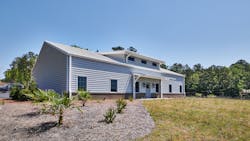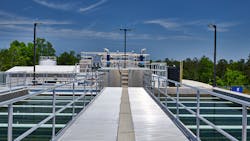Lake Greenwood Water Treatment Facility | 2022 Top Projects
Gone are the days of negotiating bulk purchase water for the Laurens County Water and Sewer Commission in South Carolina.
With its $28 million Lake Greenwood Water Treatment Facility and Raw Water Intake, the commission can forego purchasing water from three sources, and became the largest single United States Department of Agriculture funded project in history.
Taking ownership of its own facility aided the commission in avoiding increased rates for its customers with constant negotiations and most importantly in maintaining consistent quality.
By purchasing water from three sources, the chlorine residuals differed from source to source. This posed an issue with disinfection byproducts in the Laurens County system. The county selected Goodwyn Mills Cawood (GMC) as its consulting partner, and began designing the 4 million gallons per day (mgd) facility.
“GMC has been an integral part of our effort to construct a new, state-of-the-art water treatment facility on Lake Greenwood. This project represents the single, most important project in our history and GMC has been there from the beginning, involved in every step along the way,” said Jeff Field, general manager for Laurens County Water & Sewer commission.
It’s peak flow is 6 mgd, and it was constructed in such a way that expansion up to 18 mgd is possible. It uses chloramines as a disinfection residual because it will last longer in the distribution system, a valuable quality considering the rural area the distribution network covers.
Constructing the facility on Lake Greenwood necessitated the construction of 40 miles of raw water lines, a project happening in tandem with the treatment plant itself. Residents also insisted the facility be aesthetically pleasing due to its location on the bank of the lake, resulting in the facility looking like any other house on the lake.
Initially, the project designs called for a wet well, but the rock was too deep to blast and a dry well was constructed instead. This saved the project $3 million, which was diverted to pay for a pretreatment system for taste and odor, an Aqua-Aerobic Systems modular ozone generation system.
The modular system has a treatment capacity of 100 pounds per day, and internal redundancy to expand as demand grows. The operators also have controls to dynamically adapt to daily flow rates by changing how much ozone is injected into the system.
The plant also uses multi-media gravity filters to remove solids in the water that does not get settled out through the clarification process. However, performance of these filters returned residual turbidity levels higher than expected. Examination of the cores revealed the anthracite coal layer and the sand layers were not stratified. A column test directed the team to theories as to why they were overmixing for further review.
“[GMC participated] in numerous stakeholder meetings, navigating the complex State and Federal permitting process, and working closely with staff to update our distribution model and evaluate various water treatment and intake design options,” Field said. “Their commitment to providing personal service coupled with their high level of technical expertise makes GMC the perfect partner for a project of this significance. They are clearly the right firm for what we needed!”
About the Author
Bob Crossen
Bob Crossen is the vice president of content strategy for the Water and Energy Groups of Endeavor Business Media, a division of EndeavorB2B. EB2B publishes WaterWorld, Wastewater Digest and Stormwater Solutions in its water portfolio and publishes Oil & Gas Journal, Offshore Magazine, T&D World, EnergyTech and Microgrid Knowledge in its energy portfolio. Crossen graduated from Illinois State University in Dec. 2011 with a Bachelor of Arts in German and a Bachelor of Arts in Journalism. He worked for Campbell Publications, a weekly newspaper company in rural Illinois outside St. Louis for four years as a reporter and regional editor. Crossen can be reached at [email protected].



